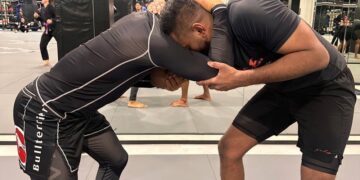
Brazilian Jiu-Jitsu is a martial art that emphasizes ground fighting. One of the most fundamental elements of BJJ is the use of various sweeps to reverse the position, thereby putting you in a good spot to initiate your offense. The double ankle sweep is one of the first sweeps you’ll learn in your grappling journey. It is a solid technique with decades of tried and tested application in Gi and No-Gi grappling, even mixed martial arts. Today, we’ll discuss this basic yet effective sweep, from its fundamental movement to practical application.
Sweeping The Opponent
Sweeps are a big part of Brazilian Jiu-Jitsu’s bottom game. When playing the bottom position, it is imperative to be threatening to your opponent at all times. You can do this by constantly off-balancing the top player (kuzushi), as well as attacking with sweeps and submissions. The double ankle sweep is a move done from the basic open guard, usually after the opponent forces your guard open by standing up. Instead of conceding position, you can use the double ankle sweep to attack immediately.
Double Ankle Sweep Breakdown
This video expertly breaks down the basics of the double ankle sweep. As mentioned previously, it is a technique mostly done from the open guard after the opponent opens your closed guard.
Open your closed guard and place your legs near the opponent’s midsection. Next, grab their legs from the outside to control their general movement. Never grab going to the inside using both hands as you might get passed quickly, instead, you can either use one hand to grab to the inside space or use the recommended technique here where you grab to the outside with both hands, cupping the opponent’s heels.
Next, place your legs near the opponent’s hips (blocking on the leg works too). This serves as a counterpoint to force the opponent backwards. Since you are holding their heels, you can easily force them to fall over, thus completing the sweep. Once on the ground, the next point of order is to go on top. You can do this by posting on one arm as you establish the top pin. An additional tip here is to grab the opponent’s lapel as you go to the top for added control.
The double ankle sweep serves as an excellent first option once you enter the general open guard. It is best to go to this sweep as soon as you lose the closed guard. You can then move to other forms of open guards like the de la riva, single leg X or X guard as you see fit.
Countering The Double Ankle Sweep
Now that we understand the basics of attacking with the double ankle sweep, the next goal is to learn the basic counter to it. After all, your training partners will eventually use this sweep against you, it is a must that you have a counter or two under your sleeve.
Let’s begin. From the guard position, stand up and open the opponent’s closed guard, this will put us in the starting position of the double ankle sweep. The first thing you need to do is to move your hips forward as you monitor their feet. Doing this instantly negates their ability to push you backwards. Next, grab their foot and drag it across your opposite hip, just like how you do a leg drag guard pass. Lower your base and grab the lapel immediately after the drag to remove any available space.
Simple Yet Effective
Techniques like the double ankle sweep are considered by many as a “white belt move”, and with good reason – it is usually taught in the first 6 months of a BJJ practitioner’s journey. While this is the case, do not dismiss the power of this humble technique. The double ankle sweep is effective across all belt levels, including championship-level competition. Legendary competitors like Roger Gracie and Marcelo Garcia have used the double ankle sweep against the best in the world. If this sweep can work for them, it will surely work for you. As the old saying goes, “Don’t judge a book by its cover”.
Technique Mastery
Learning and mastering techniques are 2 different things. It is simply not enough to just watch your instructor demonstrate the technique. A big part of your development as a grappler comes from practicing and troubleshooting the technique with your training partners. We suggest you take time to practice your newly acquired techniques every time you train. Understand the mechanics and troubleshoot every step of the way. Drill your chosen techniques with varying levels of intensity. Start with no resistance and slowly include usual reactions and defenses as you get better.
Do not hesitate to ask for feedback from your instructor and training partners, their feedback is key to your improvement. This is the secret to becoming an expert in your chosen game.
Conclusion
The double ankle sweep is a fundamental technique for a reason. It is an important piece of everyone’s development and should be treated as a core topic all things considered. The concepts you learn from the double ankle sweep like kuzushi, blocking the leg, and taking away space are foundational lessons that will carry you from the beginner to advanced levels. Therefore, take your time and learn all that you can from this technique as it will only make you a better practitioner.
Training Brazilian Jiu-Jitsu is like learning a new language. Before you become fluent in the language, you must first expose yourself with the basic vocabulary and grammar structures. Similarly, the lessons within the double ankle sweep are like the basic phrases you studied when you were a child. It is always a smart idea to revisit the basics techniques you learned as a white belt regardless of your current rank, you will surely learn more nuances to these techniques as you become a more experienced grappler.
You may also like:
Understanding Sit-Up Escapes In BJJ
4 Ways To Apply Heavy Top Pressure On Your Opponent In BJJ
In Brazilian Jiu-Jitsu, the common route towards pinning the opponent is first getting past their legs. This means that you have to pass their guard to get to their upper body. A successful guard pass…
One of the best ways to finish an opponent in BJJ is to get behind and choke them. Getting behind an opponent gives you a solid advantage as it allows you to set up different…
Brazilian Jiu-Jitsu is a grappling sport that favors fighting on multiple planes of combat. You can engage from the standing position, similar to how they do in Judo, or you can grapple with your back…
Leading a fit and healthier lifestyle should be everyone’s prerogative in this day and age. A lot of us have fallen into unhealthy habits that have left us feeling much less than our best. We’ve…
Brazilian Jiu-Jitsu is a dynamic grappling art that has captured the imagination of practitioners worldwide. What’s unique about BJJ is that you can build a game that is uniquely your own. This means that your…
Learning how to dominate your opponent positionally is one of the most important skills you need to know in Brazilian Jiu-Jitsu. BJJ is a grappling art that emphasizes using pins and submissions to finish the…
Women’s boxing is thriving right now. With several ultra-competitive divisions spawning several must-see fights, the supply is more than enough to meet the demand. The incredibly healthy state of women’s boxing has fans excited for…
Intuitive Eating is more than a dietary approach; it’s a philosophy that encourages a harmonious relationship with food. By tuning into the body’s natural cues and rejecting the diet mentality, intuitive eating fosters a sense…
Clinching is a fundamental part of Muay Thai. Its brutal nature makes the art of eight limbs stand out from other combat sports and if you can’t clinch then you will find yourself at the…
Boxing is one of the most globalized combat sports, and the top boxers remain some of the highest-paid athletes in the world. Anyone can master the sweet science and enjoy the many rewards that come…
Whether you’re seeking a new way to stay fit, a method for enhancing personal discipline, or a reliable means of self-protection, martial arts can be a rewarding and practical pursuit. However, navigating the martial arts…
The question of when to eat before martial arts training has long been debated. Some believe competitors should abstain from food for five hours or more, while others consider a more liberal approach to be…

































